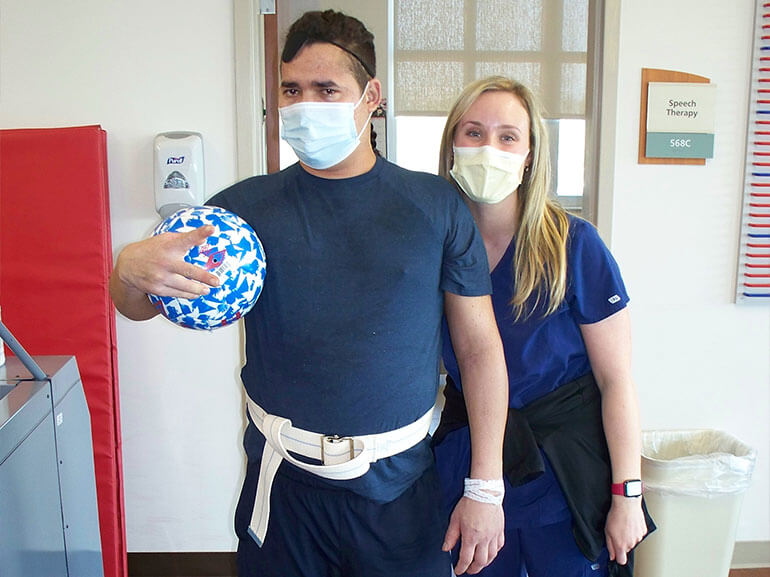Oscar's Story

Oscar Lainez, a 29-year old fisherman, was enjoying time with his wife on a Sunday morning when he started experiencing a severe headache, which would come and go over the next few days. He began to suffer from nausea and blurry vision as well. His symptoms led Oscar and his wife to suspect that he might have COVID-19, so they scheduled him to be tested later in the week.
Four days after the headaches began, Oscar began feeling dizzy, lost feeling in his left side and fell while walking in his home. The next day, his wife drove him to St. Bernard Ochsner Hospital and he was quickly transferred to Ochsner Medical Center as doctors suspected that Oscar might have suffered a stroke.
A CT scan revealed that Oscar had experienced a brainstem stroke, leaving him with weakness in his left arm and leg as well as the right side of his face. Oscar immediately underwent two surgeries, whereby part of his skull was temporarily removed to allow surgical access to his brain. During the procedures, the neurosurgeon removed a cavernoma, or a collection of abnormal blood vessels that can potentially leak blood into surrounding areas of the brain causing a stroke.
After the surgeries, Oscar experienced further medical complications including hearing loss in his right ear and a spike in blood sugar as a side effect of the steroids he was prescribed. However, Oscar was not discouraged by his setbacks, as he knew the recovery process would take time. He drew his strength and motivation from his family’s love and support. After being in the hospital for 60 days, Oscar was medically stable enough to begin his rehabilitation journey.
Upon arrival at Ochsner Rehabilitation Hospital, Oscar was experiencing weakness on the left side of his body, impaired balance, difficulty controlling and coordinating movements on the left side of his body and visual inattention on his right side. Although Oscar was able to stand and walk using a one-sided walker with minimal assistance, he still demonstrated significant deficits that affected his independence and ability to return home safely. Oscar’s physician-led team of nurses, physical, occupational and speech therapists completed assessments and determined a care plan to help him reach his goals.
In physical therapy, Oscar’s therapists used electrical stimulation to improve the weakness in his left leg. They also utilized a body-weight support system over a treadmill to improve the efficiency and quality of his walking. A second type of support system was used to improve his balance when participating in a variety of activities. Oscar loves playing soccer, so therapists utilized the support system to allow him to practice soccer skills in a safe environment while he worked on visual scanning and balance recovery without assistance.
Oscar was the first patient at Ochsner Rehabilitation Hospital to use a virtual reality system that allowed him to work with his therapists to improve his balance, negotiate obstacles and improve his ability to pay attention to obstacles on his right side through visual scanning. Physical therapists further challenged Oscar by having him complete exercises such as crawling, kneeling and arm/leg lifts while on all fours to improve his coordination, strength and balance.
Occupational therapists educated Oscar on using adaptive equipment and taught him new strategies to eat, bathe, use the bathroom and get dressed. As Oscar’s stay at Ochsner Rehabilitation Hospital progressed, his therapists also focused on increasing strength, fine motor coordination and functional grasp in his left arm.
In speech therapy, Oscar’s therapists utilized VitalStim therapy to address his facial weakness and slurred speech. Consisting of electrodes that are placed on the facial nerves to stimulate/elicit muscle contraction, the VitalStim helps increase strength, coordination and range of motion of oral facial muscles for speech and swallowing function. While attached to the VitalStim, therapists would guide Oscar in oral motor exercises and speech intelligibility drills. Because Oscar’s most severe facial weakness was in his lips, these oral motor exercises included completion of specific exercises such as blowing through a straw and swishing water around in his mouth while keeping his lips tightly sealed. Speech therapists also had Oscar practice reading sentences targeting the specific sounds that were difficult for him because of his inadequate lip closure.
During his 28 days at Ochsner Rehabilitation Hospital, Oscar made excellent strides in his recovery. His balance and strength on his left side greatly improved, although he still required occasional assistance due to balance deficits and visual deficits on his right side. At the beginning of his stay, Oscar’s speech was less than intelligible 75 percent of the time, however at discharge 95 percent of his speech was understandable and was also able to eat and drink normally without experiencing any swallowing difficulty.
Oscar describes his rehabilitation experience as “really special,” crediting his care team, wife and brothers with helping him make progress while providing him with the encouragement he needed to stay motivated so he could return home.
After a total of 88 days away from home, Oscar was most looking forward to being reunited with his Siberian husky, Bruce Wayne. Oscar provides these words of encouragement to others undergoing rehabilitation after stroke: “Don’t give up. You have to stay positive. You have to have fight in you in order to overcome your obstacles.”